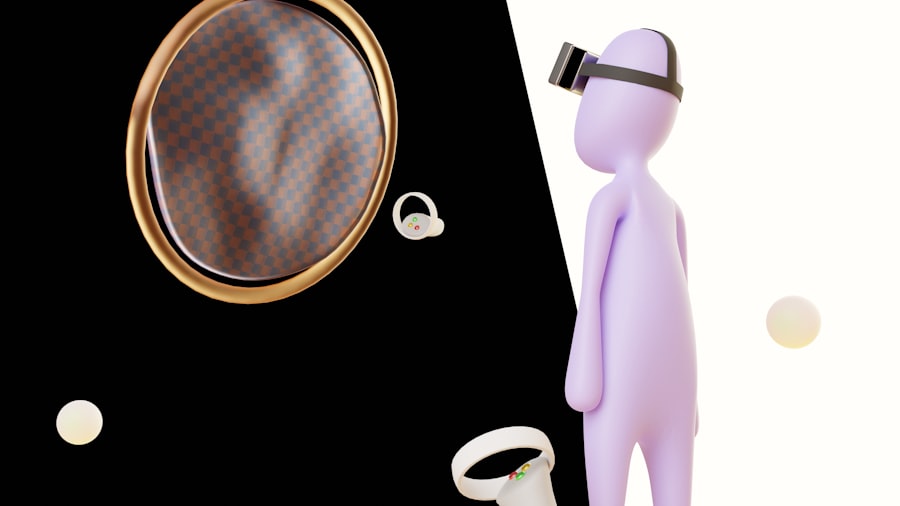Depersonalization Derealization Disorder (DPDR) is a complex mental health condition that can leave you feeling detached from your own thoughts, feelings, and sense of self. You may experience a sense of unreality regarding your surroundings, as if the world around you is distorted or dreamlike. This disorder can be disorienting and frightening, often leading to significant distress and impairment in daily functioning.
It is essential to understand that DPDR is not merely a fleeting feeling of disconnection; it is a persistent condition that can affect your quality of life. The experience of depersonalization involves feeling disconnected from your body or thoughts, as if you are observing yourself from outside your own body. On the other hand, derealization refers to the sensation that the world around you is unreal or distorted.
These experiences can occur independently or together, and they can be triggered by various factors, including stress, trauma, or anxiety. Understanding DPDR is crucial for recognizing its impact on your life and seeking appropriate help.
Key Takeaways
- Depersonalization Derealization Disorder is a mental health condition characterized by feeling detached from oneself and the surrounding environment.
- Symptoms of Depersonalization Derealization Disorder include feeling like an outside observer of one’s thoughts and actions, emotional numbness, and distorted perception of time and space.
- The causes of Depersonalization Derealization Disorder are not fully understood, but it is often linked to trauma, stress, and anxiety.
- Depersonalization Derealization Disorder is closely related to anxiety, with many individuals experiencing both conditions simultaneously.
- Depersonalization Derealization Disorder can have a significant impact on daily life, affecting relationships, work, and overall well-being.
Symptoms of Depersonalization Derealization Disorder
The symptoms of DPDR can vary widely from person to person, but they often include feelings of detachment from oneself and the environment. You might find yourself questioning your identity or feeling as though you are living in a movie or a dream. This disconnection can lead to difficulties in emotional regulation, making it challenging to connect with others or engage fully in life.
You may also experience a sense of time distortion, where time seems to speed up or slow down unexpectedly. In addition to these core symptoms, individuals with DPDR may also report physical sensations such as numbness or tingling in their limbs. You might feel as though your body is not your own or that you are unable to control your movements.
Recognizing these symptoms is the first step toward understanding and addressing the disorder.
Causes of Depersonalization Derealization Disorder

The exact causes of DPDR are not fully understood, but several factors may contribute to its development. One significant factor is trauma, particularly during childhood. If you have experienced abuse, neglect, or other traumatic events, your mind may use depersonalization as a coping mechanism to protect you from overwhelming emotions.
This dissociative response can become ingrained over time, leading to chronic feelings of detachment. Additionally, high levels of stress and anxiety can trigger episodes of depersonalization and derealization. You may find that periods of intense stress at work or in personal relationships exacerbate your symptoms.
Substance use, particularly hallucinogens or excessive alcohol consumption, can also lead to experiences of depersonalization. Understanding these potential causes can help you identify triggers and work toward managing your symptoms more effectively.
Relationship between Depersonalization Derealization Disorder and Anxiety
| Relationship between Depersonalization Derealization Disorder and Anxiety | |
|---|---|
| Depersonalization Derealization Disorder | Anxiety |
| It is a dissociative disorder characterized by feeling detached from oneself and the surroundings. | It is a mental health condition characterized by excessive worry and fear. |
| It can co-occur with anxiety disorders, such as panic disorder and social anxiety disorder. | It can be a symptom of anxiety disorders, particularly in severe cases. |
| Treatment may involve therapy, medication, and stress management techniques. | Treatment may involve therapy, medication, and relaxation techniques. |
There is a significant relationship between DPDR and anxiety disorders. Many individuals who experience DPDR also struggle with anxiety, which can create a vicious cycle. When you feel anxious, your body may respond with heightened arousal, leading to feelings of depersonalization as a way to cope with overwhelming emotions.
This detachment can then increase your anxiety levels, creating a feedback loop that is difficult to break. Moreover, the fear of experiencing depersonalization can lead to anticipatory anxiety. You might become hyper-aware of your thoughts and feelings, constantly worrying about when the next episode will occur.
This heightened state of vigilance can further exacerbate your anxiety and make it challenging to engage in everyday activities. Understanding this relationship is crucial for developing effective coping strategies and treatment plans.
Impact of Depersonalization Derealization Disorder on Daily Life
Living with DPDR can significantly impact various aspects of your daily life. You may find it challenging to maintain relationships, as the feelings of detachment can make it difficult to connect with others emotionally. Friends and family may not understand what you are experiencing, leading to feelings of isolation and loneliness.
This disconnection can also affect your ability to perform at work or school, as concentration and focus may be compromised. Additionally, the unpredictability of DPDR episodes can create a sense of fear and anxiety about engaging in social situations or new experiences. You might avoid certain activities or environments that you associate with triggering your symptoms, leading to a more restricted lifestyle.
Recognizing how DPDR affects your daily life is essential for seeking support and making necessary adjustments to improve your overall well-being.
Diagnosis of Depersonalization Derealization Disorder

Diagnosing DPDR typically involves a comprehensive evaluation by a mental health professional. During this process, you will likely discuss your symptoms, medical history, and any potential triggers for your experiences. The clinician may use standardized assessment tools to help determine the severity and frequency of your symptoms.
It is essential to provide honest and detailed information during this evaluation to ensure an accurate diagnosis. It is important to note that DPDR can sometimes be mistaken for other mental health conditions, such as anxiety disorders or depression. Therefore, a thorough assessment is crucial for distinguishing DPDR from other disorders and developing an appropriate treatment plan.
If you suspect that you may be experiencing DPDR, seeking professional help is an important step toward understanding and managing your symptoms effectively.
Treatment Options for Depersonalization Derealization Disorder and Anxiety
Treatment for DPDR often involves a combination of therapeutic approaches tailored to your specific needs. Cognitive-behavioral therapy (CBT) is one effective method that focuses on identifying and changing negative thought patterns associated with depersonalization and anxiety. Through CBT, you can learn coping strategies to manage your symptoms and reduce the impact of anxiety on your daily life.
In some cases, medication may also be prescribed to help alleviate symptoms of anxiety or depression that accompany DPDR. Antidepressants or anti-anxiety medications can provide relief for some individuals, but it is essential to work closely with a healthcare provider to determine the best course of action for your situation. Combining therapy with medication can often yield the most effective results in managing both DPDR and anxiety.
Coping Strategies for Depersonalization Derealization Disorder and Anxiety
Developing coping strategies is crucial for managing the symptoms of DPDR and anxiety effectively. Mindfulness practices can be particularly beneficial in grounding yourself during episodes of depersonalization. Techniques such as deep breathing exercises, meditation, or progressive muscle relaxation can help you reconnect with your body and surroundings when feelings of detachment arise.
Engaging in regular physical activity can also serve as an effective coping mechanism. Exercise releases endorphins that can improve mood and reduce anxiety levels. Additionally, maintaining a healthy lifestyle through proper nutrition and sleep hygiene can contribute positively to your overall mental health.
Finding activities that bring you joy and fulfillment can help counteract feelings of disconnection and promote a sense of well-being.
Support and Resources for Individuals with Depersonalization Derealization Disorder and Anxiety
Finding support is essential when navigating the challenges associated with DPDR and anxiety. Connecting with mental health professionals who specialize in dissociative disorders can provide valuable insights and guidance tailored to your needs. Support groups, both in-person and online, offer opportunities to share experiences with others who understand what you are going through.
Numerous resources are available for individuals seeking information about DPDR and anxiety management strategies. Books, articles, and reputable websites dedicated to mental health can provide additional knowledge and coping techniques. Remember that you are not alone in this journey; reaching out for support can make a significant difference in managing your symptoms.
How to Help a Loved One with Depersonalization Derealization Disorder and Anxiety
If someone close to you is experiencing DPDR and anxiety, offering support can be incredibly beneficial for their recovery process. Start by educating yourself about the disorder so that you can better understand their experiences and challenges. Listening without judgment is crucial; allow them to express their feelings without trying to fix the situation immediately.
Encourage them to seek professional help if they have not already done so. Offer to accompany them to appointments or assist them in finding resources that may be helpful. Additionally, check in regularly to see how they are doing; small gestures of support can go a long way in helping them feel less isolated during difficult times.
Research and Future Directions for Depersonalization Derealization Disorder and Anxiety
Research into DPDR is ongoing, with scientists striving to better understand its causes, symptoms, and effective treatment options. Recent studies have explored the neurobiological underpinnings of depersonalization experiences, shedding light on how brain function may contribute to these sensations. As our understanding deepens, new therapeutic approaches may emerge that offer hope for those affected by this disorder.
Future directions in research may also focus on the relationship between DPDR and other mental health conditions such as PTSD or borderline personality disorder. By examining these connections more closely, researchers hope to develop integrated treatment strategies that address multiple aspects of an individual’s mental health challenges. As awareness grows around DPDR, it is essential for continued advocacy for research funding and resources dedicated to improving the lives of those affected by this complex disorder.
In conclusion, understanding Depersonalization Derealization Disorder is vital for recognizing its impact on individuals’ lives and seeking appropriate support. By exploring its symptoms, causes, treatment options, coping strategies, and available resources, you can take proactive steps toward managing this condition effectively while fostering connections with others who share similar experiences.
Depersonalization-derealization disorder (DPDR) is a complex mental health condition often intertwined with anxiety, leading to feelings of detachment from one’s own body or surroundings. Understanding the nuances of this disorder can be crucial for effective treatment and management.
This resource provides valuable information on how these conditions intersect and offers guidance on coping strategies. For more detailed insights, you can read the article by visiting




